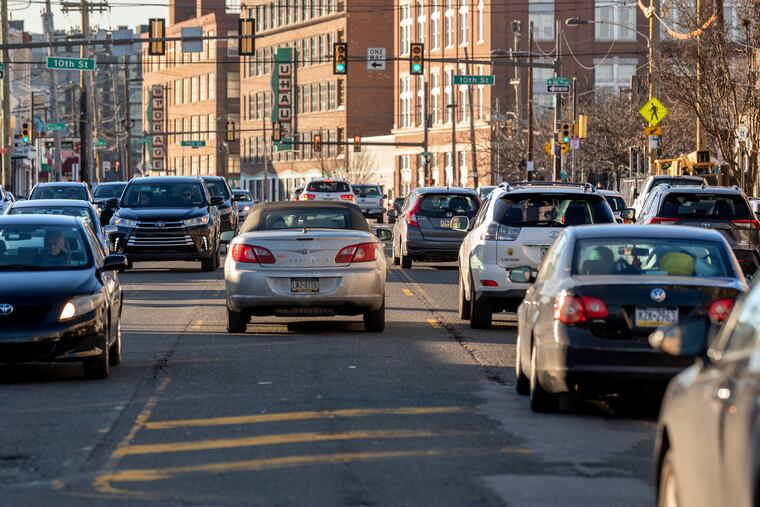After all that, Washington Avenue could end up with two separate safety configurations
The eastern end of Washington Avenue could get the latest in traffic calming approaches, while the western end would remain five lanes.

A March compromise plan to put Washington Avenue on a mixed-road diet with fewer lanes in some sections and new traffic-calming features seemed to offer a chance to make the thoroughfare safer and end a nine-year battle.
But Councilmember Kenyatta Johnson on Thursday declined to introduce legislation changing parking rules on the part of the avenue in his district, meaning it would be repaved but stay five lanes wide.
Councilmember Mark Squilla introduced a bill enabling parking and loading-zone changes on Washington Avenue in his district, from Fourth Street to Broad Street.
The city’s Office of Transportation, Infrastructure, and Sustainability (OTIS) wants to begin repaving the entire 2.1-mile stretch from Fourth Street to Grays Ferry Avenue this summer. It hasn’t been repaved in two decades.
Thursday was the last day legislation could be introduced and still move to final passage by City Council’s last session before summer break on June 23.
Johnson said he wants Washington Avenue to remain five lanes through the 2nd District, reflecting the needs and concerns of residents and business owners.
Help us make our Business coverage better for you: We may change parts of the Business section and need your help. Complete our anonymous survey and you can enter to win a $75 American Express gift card.
“I support installing needed safety protections along Washington Avenue, which includes things like speed cushions, curb cuts, better lighting and traffic signals, [and] more school crossing guards,” Johnson said in a statement. He added he thought that could be done without shrinking the number of lanes.
That is not clear, since those safety measures were predicated on a plan that included fewer lanes on parts of the avenue.
“The Washington Avenue project was designed comprehensively with each element integral to an overall design to improve safety and support a healthy business corridor,” OTIS said in a statement, including “increased parking and loading options.”
Squilla’s legislation also includes a requirement that the city conduct traffic studies on Washington Avenue and ancillary roads to the north and south, one year and two years after the changes.
“Is it really safer?” Squilla said. “We will be able to determine if the changes are working as intended or if there were unintended consequences.”
Some advocates were disappointed in Johnson’s decision. “After all of the time invested in accommodating community input, he is poised to reject safety, something that thousands of his constituents have spent years asking for,” the Bicycle Coalition of Greater Philadelphia said in a post on its website.
The mixed plan came after a backlash against OTIS’ original plan, announced in September 2020, to narrow the entire 2.1-mile stretch of Washington Avenue from five vehicle travel lanes to three — a design meant to cut vehicle crashes, make walking safer, and protect cyclists by placing bike lanes between parked cars and curbs.
City officials abandoned that plan Feb. 6. They had reopened the public-engagement process last year because they said the earlier round in 2020 did not adequately represent the concerns of people of color in the Grays Ferry and Point Breeze neighborhoods, as well as business owners along the avenue.
“It’s a shame that some people want to tell other people the type of transportation they should use to move around,” said Alfred Littlepage, a community leader in Point Breeze. “A lot of these groups seem to be in favor of limiting vehicles altogether.”
Repaving and adding new lane markings will cost about $6.2 million, most from federal funds, OTIS has said. The cost to the city: $1.24 million.
Officials estimate the other elements, such as speed cushions and bus-boarding islands, would cost about $2 million more.
Squilla’s bill is scheduled to be heard in committee on June 7.
“It is our hope Councilmember Johnson will introduce an amendment to include the 2nd District as well,” OTIS said in its statement.